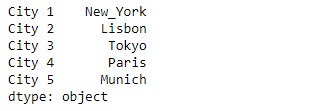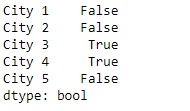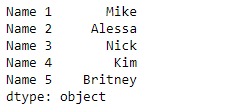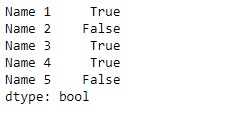Series.str可用于以字符串形式访问系列的值并对其应用几种方法。 Pandas Series.str.match()函数用于确定给定系列对象的基础数据中的每个字符串是否与正则表达式匹配。
用法: Series.str.match(pat, case=True, flags=0, na=nan)
参数:
pat : 具有捕获组的正则表达式模式。
case : 如果为True,则区分大小写
flags : 一个re模块标志,例如re.IGNORECASE。
na : 默认NaN,填充缺失值的值
返回值:布尔值的序列/数组
示例1:采用Series.str.match()函数,以将传递的正则表达式与给定series对象的基础数据中的字符串进行匹配。
# importing pandas as pd
import pandas as pd
# importing re for regular expressions
import re
# Creating the Series
sr = pd.Series(['New_York', 'Lisbon', 'Tokyo', 'Paris', 'Munich'])
# Creating the index
idx = ['City 1', 'City 2', 'City 3', 'City 4', 'City 5']
# set the index
sr.index = idx
# Print the series
print(sr)输出:

现在我们将使用Series.str.match()函数,以将传递的正则表达式与给定series对象的基础数据中的字符串进行匹配。
# match either 'Tokyo' or 'Paris'
result = sr.str.match(pat = '(Tokyo)|(Paris)')
# print the result
print(result)输出:

正如我们在输出中看到的,Series.str.match()函数已返回一系列布尔值。它包含了True对于那些成功匹配其他值的值False。
示例2:采用Series.str.match()函数,以将传递的正则表达式与给定series对象的基础数据中的字符串进行匹配。
# importing pandas as pd
import pandas as pd
# importing re for regular expressions
import re
# Creating the Series
sr = pd.Series(['Mike', 'Alessa', 'Nick', 'Kim', 'Britney'])
# Creating the index
idx = ['Name 1', 'Name 2', 'Name 3', 'Name 4', 'Name 5']
# set the index
sr.index = idx
# Print the series
print(sr)输出:

现在我们将使用Series.str.match()函数,以将传递的正则表达式与给定series对象的基础数据中的字符串进行匹配。
# match groups having any capital letter
# followed by 'i' and any other character
result = sr.str.match(pat = '([A-Z]i.)')
# print the result
print(result)输出:

正如我们在输出中看到的,Series.str.match()函数已返回一系列布尔值。它包含了True对于那些成功匹配其他值的值False。
相关用法
- Python pandas.map()用法及代码示例
- Python Pandas.pivot_table()用法及代码示例
- Python Pandas Timestamp.now用法及代码示例
- Python Pandas.pivot()用法及代码示例
- Python Pandas.melt()用法及代码示例
- Python Pandas Timestamp.dst用法及代码示例
- Python Pandas Index.max()用法及代码示例
- Python Pandas.CategoricalDtype()用法及代码示例
- Python Pandas Index.all()用法及代码示例
- Python Pandas Index.any()用法及代码示例
- Python Pandas Timestamp.tz用法及代码示例
- Python Pandas Timestamp.second用法及代码示例
- Python Pandas Series.mul()用法及代码示例
- Python Pandas Series.div()用法及代码示例
- Python Pandas Series.pow()用法及代码示例
注:本文由纯净天空筛选整理自Shubham__Ranjan大神的英文原创作品 Python | Pandas Series.str.match()。非经特殊声明,原始代码版权归原作者所有,本译文未经允许或授权,请勿转载或复制。
